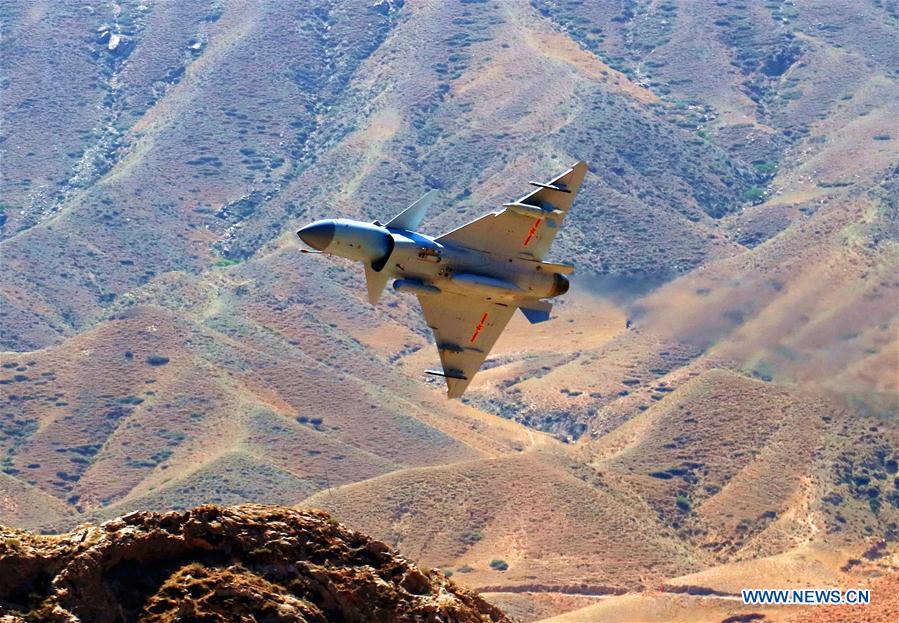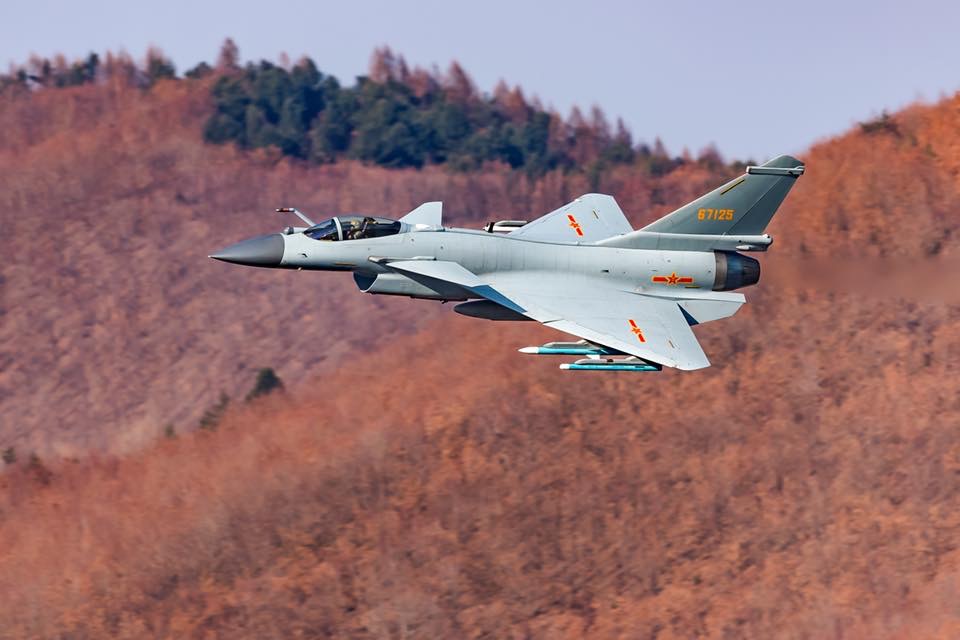How good is China’s J-10C fighter? We ask Justin Bronk from the RUSI think-tank
 The Chinese J-10 is in service in large, and growing, numbers. The latest version, the J-10C, is a formidable machine. We spoke to Justin Bronk, Research Fellow for Airpower and Technology at the RUSI think-tank to find out more.
No nation has more new aircraft programmes than China, and the progress it has made in the twenty years has been spectacular. In the field of fighter aircraft much media attention has been paid to the rather spectacular J-20, a monstrous stealthy combat aircraft comparable in some respects to the US’ F-22, while less has been paid to the J-10.
The Chinese J-10 is in service in large, and growing, numbers. The latest version, the J-10C, is a formidable machine. We spoke to Justin Bronk, Research Fellow for Airpower and Technology at the RUSI think-tank to find out more.
No nation has more new aircraft programmes than China, and the progress it has made in the twenty years has been spectacular. In the field of fighter aircraft much media attention has been paid to the rather spectacular J-20, a monstrous stealthy combat aircraft comparable in some respects to the US’ F-22, while less has been paid to the J-10.
 The J-10 entered service in 2006 and since than around 350 have been built, more than the number of French Rafale, or Swedish Gripen and very close to the number of F-35s. With an estimated empty weight of 8850 kg and maximum weight of 19277 kg it is comparable to the F-16, as is its reheated thrust of around 130kN. The latest version, the J-10C, is the most potent – with a modern AESA radar and the ability to carry the PL-15 long range air-to-air missile, a formidable weapon in the same class as Europe’s much lauded Meteor. We asked Justin Bronk how the aircraft would fare against the F-16, the most widely used modern fighter aircraft.
The J-10 entered service in 2006 and since than around 350 have been built, more than the number of French Rafale, or Swedish Gripen and very close to the number of F-35s. With an estimated empty weight of 8850 kg and maximum weight of 19277 kg it is comparable to the F-16, as is its reheated thrust of around 130kN. The latest version, the J-10C, is the most potent – with a modern AESA radar and the ability to carry the PL-15 long range air-to-air missile, a formidable weapon in the same class as Europe’s much lauded Meteor. We asked Justin Bronk how the aircraft would fare against the F-16, the most widely used modern fighter aircraft.
 “On J-10C in Beyond Visual Range combat; kinematically, it is likely to be somewhere close to a later Block F-16; the original J-10A’s thrust-weight ratio most likely having degraded due to weight growth as more advanced sensors, stores and kit such as HMS have been added.” — the J-10C’s thrust-to-weight, an important measure for how ‘energetic’ the aircraft is, remains decent- above 1.1 -1 in a typical combat configuration. “With a light airframe, relaxed stability, decent (although not stellar) thrust to weight ratio and large canards, the J-10C is very agile in airshow configuration and the option for thrust vectoring only increases this capability at low speeds. However, the light airframe and small size relative to fighters like the J-20, Typhoon or F-15 mean that external stores and fuel tanks will have a more serious impact on both performance and agility than on larger fighters.”
“On J-10C in Beyond Visual Range combat; kinematically, it is likely to be somewhere close to a later Block F-16; the original J-10A’s thrust-weight ratio most likely having degraded due to weight growth as more advanced sensors, stores and kit such as HMS have been added.” — the J-10C’s thrust-to-weight, an important measure for how ‘energetic’ the aircraft is, remains decent- above 1.1 -1 in a typical combat configuration. “With a light airframe, relaxed stability, decent (although not stellar) thrust to weight ratio and large canards, the J-10C is very agile in airshow configuration and the option for thrust vectoring only increases this capability at low speeds. However, the light airframe and small size relative to fighters like the J-20, Typhoon or F-15 mean that external stores and fuel tanks will have a more serious impact on both performance and agility than on larger fighters.”
 China has long struggled with aero-engine technology, so how good are the J-10C’s WS10s? “The WS-10 series has suffered from persistent problems with engine life, mean time between failures and throttle-spool response time. Whilst it has improved sufficiently to enter quantity production for later J-10Bs and J-11s, the Russian AL-31FN Series 3 developed for the J-10B is still a superior engine on almost all metrics aside from cost. Chinese military turbofan engines are improving rapidly but are at best only at par with Russian equivalents and are not yet in a position to compete directly with European or American designs.”
China has long struggled with aero-engine technology, so how good are the J-10C’s WS10s? “The WS-10 series has suffered from persistent problems with engine life, mean time between failures and throttle-spool response time. Whilst it has improved sufficiently to enter quantity production for later J-10Bs and J-11s, the Russian AL-31FN Series 3 developed for the J-10B is still a superior engine on almost all metrics aside from cost. Chinese military turbofan engines are improving rapidly but are at best only at par with Russian equivalents and are not yet in a position to compete directly with European or American designs.”
 Bronk believes the Pl-15 is not yet fully operational, “The PL-15 is certainly being shown off on carriage flights with a number of different PLAAF types, so being somewhere around what we in the West would term Initial Operating Capability but not near Full Operational Clearance is probably a decent bet. There is a fair bit of concern in the US fighter community about the PL-15; its size and design should allow it to technically outrange the AIM-120 series and a proper active radar seeker head gives a lot more tactical options than older semi-active Russian and Chinese ‘sticks’.”
Though mechanically scanned radars are considered a technologically of the past, they remain the most common fighter sensor in the West. The J-10C has an Active Electronically Scanning Array radar, “Finally, its AESA radar should give the J-10C a significant advantage over older Mech-Scan equipped F-16s in the BVR arena; although having a great deal more experience in the technology, American fighter AESA sets are likely to remain superior where fitted especially in terms of advanced low-probability of intercept/detection (LPI/LPD) scanning modes.” In summary, Bronk firmly places the J-10C in Generation 4.5* “All in all, the J-10C is a significant leap into true ‘4.5th Generation’ capability for the PLAAF compared to the earlier variants of this distinctive bird.
*something he defines as including “low-observability to radar; the ability to supercruise (fly at supersonic speed without using afterburners); and extreme manoeuvrability at all speeds.”.
Bronk believes the Pl-15 is not yet fully operational, “The PL-15 is certainly being shown off on carriage flights with a number of different PLAAF types, so being somewhere around what we in the West would term Initial Operating Capability but not near Full Operational Clearance is probably a decent bet. There is a fair bit of concern in the US fighter community about the PL-15; its size and design should allow it to technically outrange the AIM-120 series and a proper active radar seeker head gives a lot more tactical options than older semi-active Russian and Chinese ‘sticks’.”
Though mechanically scanned radars are considered a technologically of the past, they remain the most common fighter sensor in the West. The J-10C has an Active Electronically Scanning Array radar, “Finally, its AESA radar should give the J-10C a significant advantage over older Mech-Scan equipped F-16s in the BVR arena; although having a great deal more experience in the technology, American fighter AESA sets are likely to remain superior where fitted especially in terms of advanced low-probability of intercept/detection (LPI/LPD) scanning modes.” In summary, Bronk firmly places the J-10C in Generation 4.5* “All in all, the J-10C is a significant leap into true ‘4.5th Generation’ capability for the PLAAF compared to the earlier variants of this distinctive bird.
*something he defines as including “low-observability to radar; the ability to supercruise (fly at supersonic speed without using afterburners); and extreme manoeuvrability at all speeds.”.


Dear aviation aficionado,
This site is in danger due to a lack of funding, if you enjoyed this article and wish to donate you may do it here.
You love planes. We love planes. Save the Hush-Kit blog! Our site is absolutely free and we have no advertisements.


Somewhere an IAI Lavi would be happy that it’s legacy continues. 😛
oh right the Israeli knock off of the F-16…
The J-10 was developed from the J-9 of the Chengdu Aircraft Design Institute. The J-9 was designed in the 1960s. The design goal was to intercept the Soviet Tu-22M and the US B-1B. However, due to insufficient engine performance, the flight performance of the J-9 could not meet the design targets, so it was planned to cancel in the late 1970s.In the 1960s design, the J-9 had adopted the long arm canard.IAI LAVI is close coupled canard, which is completely different. More similar to EF2000.
Surely you need to ask about the JF-17?
I already have – search our archives 😉
Your interview series with fighter pilots is great. You may consider the following for PAF fans;
1. Interview of F-7PG pilot, especially their experience of multinational excercise
2 Feedback from JF-17 pilot about recent exercise in Turkey and China.
3. Interview of Mirage Rose-II/III pilot.
4. Interview of F-16MLU pilot focusing on multinational Red Flag exercise.
Nice Article. Impressive fighter indeed
Most likely WS10C engine still underpowered for J10 design. (Perversely low speed cruise consumes power just to lift delta rear end). Results in more afterburner use and lower climb rate according to some Chines e blog sites.